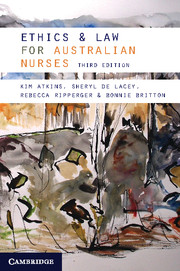LEARNING OBJECTIVES
In this chapter, you will:
➔ Gain an understanding of the nature of professional self-respect and its connection to trustworthiness
➔ Gain an understanding of the nature of trust and its role in the clinical relationship
➔ Gain an understanding of the factors that lead to clinical errors and incidents
➔ Gain an understanding of some factors that influence nurses’ decisions about reporting errors
➔ Gain an understanding of how you can build integrity through ‘Giving Voice to Values’
➔ Learn about open disclosure policy and processes
Apari had been caring for a diabetic man, Jack, whose blood glucose levels had been difficult to stabilise. One day they would be high, the next day they would be low. By chance, one day Apari saw that a new nurse, Louise, was using the glucometer incorrectly to test Jack's blood glucose. Apari checked Jack's notes and realised that Louise had been recording incorrect blood glucose levels for several days.
Just like everyone else, nurses sometimes make mistakes that can result in harm to others. The Nursing and Midwifery Board of Australia (NMBA) Code of Professional Conduct for Nurses in Australia (NMBA 2013d) makes a number of statements regarding safe conduct – for example:
Conduct Statement 1: Nurses practise in a safe and competent manner.
Conduct Statement 2: Nurses practise in accordance with the standards of the profession and broader health system.
Conduct Statement 3: Nurses practise and conduct themselves in accordance with laws relevant to the profession and practice of nursing.
The NMBA Code of Ethics for Nurses in Australia (NMBA 2013b) also refers to safe conduct:
Value Statement 1: Nurses value quality nursing care for all people.
Value Statement 6: Nurses value a culture of safety in nursing and health care.
These statements reflect the expectation that nurses are aware of and committed to industry-wide standards of safety and quality in their practice. Consequently, one could infer that nurses have a moral obligation to deal with clinical errors and incidents in an open, honest and constructive fashion. For example, Value Statement 1 further states:
Valuing quality nursing care involves nurses accepting accountability for the standard of nursing care they provide, helping to raise the standard of nursing care, and taking action when they consider, on reasonable grounds, the standard of nursing care to be unacceptable.
